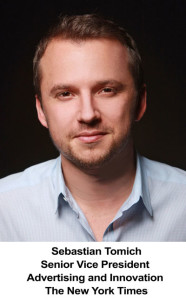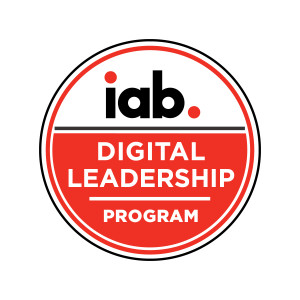In a digital media ecosystem where publishers are struggling to uncover new sources of revenue, The New York Times is thriving: in just two years, the company quietly grew its in-house brand marketing unit, T Brand Studio, into a core business unit that generates 20% of all digital ad revenue. While some media brands are stressed by the need to unlock growth opportunities, the Times is positioned to scale its early successes and double T Brand’s headcount, client base, and revenue in 2016.
So what makes the Times so different from fellow companies in the media industry who are scrambling to find new monetization sources? The answer is simple: it’s the people. The Times hires leaders who are curious learners, tenacious problem-solvers, and talented tinkerers.
Sebastian Tomich, Senior Vice President of Advertising and Innovation, among other things, leads the Times’ T Brand Studio. His team members are teaching a session on Storytelling for Digital Advertising for the June 7-8, IAB Digital Leadership Program. We asked Sebastian to share the leadership lessons he’s learned, along with his best tips for innovation:
1. Always challenge assumptions and norms
Tomich and his team originally launched T Brand Studio as a solution for developing native ad campaigns. Very quickly, however, the Times realized that there was a clear opportunity to grow this business unit into something bigger.
“The media industry has quickly jumped to create sponsored content and equate them with native ads,” says Tomich. “I don’t think that’s necessarily the answer—or that the digital media industry knows exactly what the answer is.”
 Instead of following the footsteps of other publishers, Tomich and his team decided to create an ad product that was natural to the Times’s existing growth trajectory and strengths.
Instead of following the footsteps of other publishers, Tomich and his team decided to create an ad product that was natural to the Times’s existing growth trajectory and strengths.
“We created an ad format that has the same cues as our core site experience,” says Tomich. “We have a good sense of what audiences need, and we’re using this information to redefine our business models.”
2. Aim to unlock existing sources of value
The solution to many of media’s revenue and monetization challenges are already out there. Building upon step one (above), publishers need to venture out and rediscover their existing assets. It was this perspective that helped Tomich and his team expedite their time to market and unlock early sources of growth.
“We have some of the best tools to create content, along with some of the best talent in the media world,” says Tomich. “It made sense to launch an in-house creative agency and help brands create content.”
The New York Times, as a media company, offers a perspective to branded content creators that no other organization can. It’s this reason why Tomich expects “creative services to become a bigger part of the business.”
3. Lead with confidence
Even for an established innovator like The New York Times, Tomich and his team have needed to be persistent. It’s not easy to get organizational buy-in for a new idea—especially if an early initiative needs resources to build.
“But new initiatives lead to new profit margins,” says Tomich. “We need to be persistent in campaigning for the successes that we want to see.”
These initiatives don’t need to be risky. At the heart of the Times’ exploration process and innovation is a reliance on user research and data. Rather than following the status quo or taking a leap of faith, Tomich and his team have adapted organically to changing market conditions and audience demands for quality content, exploring new terrain and introducing new content solutions to the market. The research indicates that, Paid Posts created by T Brand Studio outperformed Paid Posts produced by the advertiser. Specifically, T Brand Studio-produced content generated 361% more unique visitors and 526% more time spent than advertiser-produced content.
“The classic challenge that media companies face is how to create an agile, startup-like mentality when you’re a part of the business that requires a lot of processes and templating,” says Tomich. “You don’t want to take leaps of faith. You don’t want to be too cocky, but you do want to maintain a position as a leader in the market.”
As Tomich and his team at T Brand Studio have demonstrated, staying ahead of a crowded and fast-moving ecosystem demands expertise, vision, and the well-founded confidence to advocate for that vision. That combination is what separates leaders like Tomich from the crowd, and in turn, enables The New York Times to maintain its position at the forefront of the digital media landscape.
 IAB Digital Leadership Program teaches professionals the skills required for senior management roles in digital media and advertising. This three-day intensive course is designed for indviduals on the path to executive roles and is taught by industry leaders from T Brand Studio, Bloomberg Media, Oracle and more. Our next session is June 7-8th in NYC. iab.com/leadership
IAB Digital Leadership Program teaches professionals the skills required for senior management roles in digital media and advertising. This three-day intensive course is designed for indviduals on the path to executive roles and is taught by industry leaders from T Brand Studio, Bloomberg Media, Oracle and more. Our next session is June 7-8th in NYC. iab.com/leadership




